

 |
Search the Site with

|
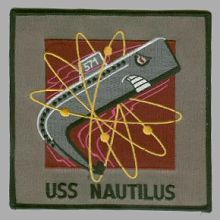 | 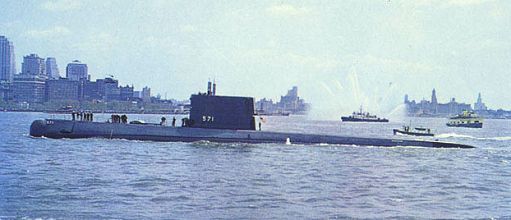 |
USS NAUTILUS was the Navy's first nuclear-powered vessel and the fourth ship in the Navy to bear the name. She was also the world's first ship to reach the geographic North Pole. Both decommissioned and stricken from the Navy list on March 3, 1980, the NAUTILUS became a museum on May 20, 1982 and is now located at the Historic NAUTILUS & Submarine Force Museum at New London, Conn. Click here for a photo tour of the preserved NAUTILUS.
| General Characteristics: | Awarded: August 2, 1951 |
| Keel laid: June 14, 1952 | |
| Launched: January 21, 1954 | |
| Commissioned: September 30, 1954 | |
| Decommissioned: March 3, 1980 | |
| Builder: Electric Boat Division of General Dynamics Corporation, Groton, CT. | |
| Propulsion system: one nuclear reactor | |
| Propellers: two | |
| Length: 324 feet (98.75 meters) | |
| Beam: 27.8 feet (8.47 meters) | |
| Draft: 22 feet (6.7 meters) | |
| Displacement: Surfaced: approx. 3,530 tons Submerged: approx. 4,090 tons | |
| Speed: Surfaced: approx. 22 knots Submerged: approx. +20 knots | |
| Armament: six 533 mm torpedo tubes | |
| Crew: 13 Officers, 92 Enlisted |
Crew List:
This section contains the names of sailors who served aboard USS NAUTILUS. It is no official listing but contains the names of sailors who submitted their information.
Accidents aboard USS NAUTILUS:
| Date | Where | Events |
|---|---|---|
| September 16, 1954 | Groton, Conn. | Several weeks before her first sea trials, a small steam pipe in the reactor department of the NAUTILUS bursts, filling the area with steam during a test of the steam system while the submarine is at Electric Boat Shipyard. The test is part of a quality control effort to check the adequacy of the shipyard's inspection system. The incident initially appears to be minor. There are slight personnel injuries and no radiation hazards. However, a subsequent investigation shows the situation is more serious. Specifications called for seamless pipe, but ordinary stanchion pipe had been used. All suspect pipe is ripped out and the mistake leads to more stringent quality control measures. |
| May 11, 1955 | off Groton, Conn. | USS NAUTILUS suffers a small leak in a fresh water line in the steam plant as the submarine leaves on its shakedown cruise from Groton, Conn., forcing the NAUTILUS to return to port for quick repairs. The Navy says the leak did not involve the reactor. |
| April 22, 1956 | 140 miles off the New Jersey coast | USS NAUTILUS is snared in the nets of a fishing vessel off the New Jersey coast, southest of New York, while running at a depth of 150 feet. The NAUTILUS nearly drags the vessel under water, but the submarine is unaware of the mishap, does not surface and continues to Groton, Conn. The estimated damage is $1,300 to each vessel. |
| April 28, 1956 | New London, Conn. | USS NAUTILUS suffers a fire caused by a welder's torch, during repairs of damage caused by snaring of a fishing net on April 22. The blaze ignites cork insulation and burns paint from the hull. The Navy reports that damage from the fire, the third to break out on the NAUTILUS, is slight. |
| October 15, 1956 | During the height of the Suez crises, the USS NAUTILUS accidentally fires two dummy practice torpedoes at a British merchant vessel during naval exercises in European waters. The NAUTILUS mistakes the ship for an aircraft carrier on its sonar. | |
| September 1957 | Arctic | USS NAUTILUS suffers damage to two periscopes while rising under ice conditions during an exploratory trip under the Arctic pack ice. The NAUTILUS returns to the open sea to perform repairs on the surface. It takes 12 hours in rough seas, freezing temperatures, and gale winds to fix one periscope. The other one is damaged beyond repair. |
| November 1957 | Groton, Conn. | According to the Washington Post, the reactor compartment of the USS NAUILUS is flooded after a small leak developed while the submarine was in port. The leak was due to the malfunctioning of a valve, and according to the Navy caused no radioactive contamination or damage to the power plant. |
| April 25, 1958 | off the US east coast | USS NAUTILUS experiences a small saltwater leak in one of the steam condensers shortly after leaving Groton, Conn., as the NAUTILUS heads south toward the Panama Canal to transit to the Pacific for her expedition to the North Pole. After passing through the Canal and experiencing a fire on May 4, 1958, the NAUTILUS puts into Mare Island Naval Shipyard, San Francisco, Calif., for repairs. However, the source of the leak cannot be pinpointed and the ship proceeds to Seattle, Wash. During the trip to Seattle, the captain decides to use the same type of additive that is sold for leaky car radiators to try to repair the leak in the condenser. Upon arriving in Seattle, 140 quarts are purchased and half are poured into the cooling system. The reactor plant is started and the leak is stopped. |
| May 4, 1958 | eastern Pacific | USS NAUTILUS suffers a fire in the insulation around one of her turbines as the ship is running submerged in the Pacific shortly after leaving Panama on her way to her Arctic mission. The insulation had become oil-soaked during the submarine's three years of operation and had caught fire. The fire is put out with minor injuries, but the NAUTILUS had to surface to ventilate. |
| April 1959 | off Newfoundland | A compartment aboard the USS NAUTILUS is partly flooded because of a ruptured water pipe while the submarine is operating submerged. No injuries are reported. |
| October 15, 1959 | Portsmouth Naval Shipyard, New Hampshire | "Appearently intentional" damage to electrical cables of the NAUTILUS is discovered during overhaul. The Navy says the damage appears to be confined to the electrical system and does not extend to the nuclear reactor plant. The Navy disclosure of the incident follows an article in the Portsmouth Herald which reports a series of incidents involving "sabotage-type" damage to the submarine including fires, cut cables, broken pipes, and other damage to vital parts. |
| June 8, 1960 | Portsmouth Naval Shipyard, New Hampshire | Sabotage is suspected in an incident involving damage to a shipyard fire hose used on board the USS NAUTILUS for testing the ship's evaporators while the NAUTILUS is undergoing overhaul. The Navy says that no damage occurred to the ship. |
| late November 1960 | Portsmouth Naval Shipyard, New Hampshire | Six men are soaked by reactor coolant while working aboard the USS NAUTILUS. One man accidentally bumped a valve releasing the water onto himself and the others. Clothes and dosimeters were thrown away, making radiation measurement impossible. |
| November 11, 1966 | 350 miles east of Morehead City, NC | USS NAUTILUS collides with the USS ESSEX (CV 9) while running submerged during underway replenishment exercises. Both ships return to port unassisted. The submarine receives extensive damage to its sail area and goes to New London, CT. The ESSEX sustains an open hull cut in the bow area and proceeds to Norfolk, Va. |
History of USS NAUTILUS:
USS NAUTILUS was laid down 14 June 1952, President Harry S. Truman officiating, at the Electric Boat Co., Division of General Dynamics Corp., Groton, Connecticut; launched 21 January 1954; sponsored by Mrs. Dwight D. Eisenhower, wife of President Eisenhower, and commissioned 30 September 1954, Comdr. E. P. Wilkinson in command.
Following commissioning NAUTILUS remained at dockside for further construction and testing until 17 January 1955. Then, at 1100, her lines were cast off and she was "underway on nuclear power." Trials followed and on 10 May NAUTILUS headed south for shakedown. She remained submerged while enroute to Puerto Rico, covering 1,381 miles in 89.8 hours, the longest submerged cruise, to that date, by a submarine, and at the highest sustained submerged speed ever recorded for a period of over one hour's duration. Throughout 1955, and into 1957, she investigated the effects of the radically increased submerged speed and endurance, such changes in submerged mobility having virtually wiped out progress in anti-submarine warfare techniques. The airplane and radar, which helped defeat submarines in the Atlantie during World War II, proved ineffective against a vessel which did not need to surface, could clear an area in record time, and swiftly change depth simultaneously.
On 4 February 1957, NAUTILUS logged her 60,000th nautical mile to bring to reality the achievements of her fictitious namesake in Jules Verne's 20,000 Leagues Under the Sea. In May she departed for the Pacific Coast to participate in coastal exercises and the fleet exercise, operation "Home run," which acquainted units of the Pacific Fleet with the capabilities of nuclear submarines.
NAUTILUS returned to New London 21 July and departed again 19 August for her first voyage, of 1,383 miles, under polar pack ice. Thence, she headed for the Eastern Atlantic to participate in NATO exercises and conduct a tour of various British and French ports where she was inspected by defense personnel of those countries. She arrived back at New London 28 October, underwent upkeep, and then conducted coastal operations until the spring.
On 25 April 1958 she was underway again for the West Coast. Stopping at San Diego, San Francisco, and Seattle she began her history making Polar transit, operation "Sunshine," as she departed the latter port 9 June. On 19 June she entered the Chukchi Sea, but was turned back by deep draft ice in those shallow waters. On the 28th she arrived at Pearl Harbor to await better ice conditions. By 23 July her wait was over and she set a course northward. She submerged in the Barrow Sea Valley 1 August and on 3 August, at 2315 (EDST) she became the first ship to reach the geographic North Pole. From the North Pole, she continued on and after 96 hours and 1830 miles under the ice, she surfaced northeast of Greenland, having completed the first successful voyage across the North Pole.
Proceeding from Greenland to Portland, England, she received the Presidential Unit Citation, the first ever issued in peace time, from American Ambassador J. H. Whitney, and then set a westerly course which put her into the Thames River estuary at New London 29 October. For the remainder of the year she operated from her homeport, New London, Connecticut.
Following fleet exercises in early 1959, NAUTILUS entered the Portsmouth Naval Shipyard, for her first complete overhaul (28 May 1959 - 15 August 1960). Overhaul was followed by refresher training and on 24 October she departed New London for her first deployment with the 6th Fleet in the Mediterranean, returning to her homeport 16 December.
NAUTILUS operated in the Atlantic, conducting evaluation tests for ASW improvements, participating in NATO exercises and, during the fall of 1962, in the naval quarantine of Cuba, until she headed east again for a two month Mediterranean tour in August 1963. On her return she joined in fleet exercises until entering the Portsmouth Naval Shipyard for her second overhaul 17 January 1964. On 2 May 1966, NAUTILUS returned to her homeport to resume operations with the Atlantic Fleet. For the next year and a quarter she conducted special operations for ComSubLant and then in August 1967, returned to Portsmouth, for another year's stay, following which she conducted exercises off the southeastern seaboard. She returned to New London in December 1968.
The submarine spent most of the next two years in an extended upkeep and restricted availability status, carrying out independent submarine type training while intermittently tending to new equipment troubles. NAUTILUS also conducted half a dozen ASW exercises with other surface ships and submarines in the Narragansett Bay, Virginia Capes and Jacksonville operating areas. In October 1970, she also participated in ASW Exercise "Squeezeplay VI", an evaluation of the new AN/SQS-26 sonar system and the effectiveness of coordinated air, surface and submarine forces against an "opposing force" (i.e. NAUTILUS) of nuclear-powered enemy submarines. The submarine participated in three more iterations of those exercises in the spring and summer of 1971, as well as providing evaluation services for aircraft-mounted ASW systems, with a final role in Exercise "Squeezeplay XI" conducted in June 1972. She then entered the General Dynamics Shipyard at Groton for an overhaul on 15 August.
After completing post-overhaul sea trials on 23 December 1974, NAUTILUS conducted an outstanding shakedown and refresher training cruise followed by Fleet Exercise "Agate Punch" in April. Success in both endeavors allowed the submarine her first Mediterranean deployment in a decade, with the boat visiting La Spezia, Italy, soon after her arrival there on 6 July 1975. The cruise took the submarine into the central Mediterranean and Ionian Sea, where she trained 6th Fleet units in ASW techniques, and then on to the North Atlantic. After participating in a special operation the warship returned home, returning to New London via Holy Loch, Scotland, on 20 December.
Following a holiday standown period, NAUTILUS began a year long series of West Indies cruises in the spring of 1976, conducting weapons certification tests, supporting special forces exercises and conducting equipment development evaluations for the Chief of Naval Operations. The following April, the submarine departed New London for another Mediterranean cruise, where she participated in "Dawn Patrol" and other NATO exercises. During the cruise she visited Lisbon, Portugal; Sousse, Tunisia; La Maddalena, Sardinia; and Taranto and Naples in Italy before returning to New London in September 1977.
NAUTILUS began 1978 slowly, with a six-week upkeep followed by a short dependents cruise in early March. Later that month, the submarine conducted a six-week oceanographic research deployment cruise, which included a port visit to Bermuda. After a summer of interim repair work to replace faulty hydrophones, the crew observed the twentieth anniversary of the historic polar voyage to the north pole on 3 August. This milestone was followed by another in December, when NAUTILUS logged her 500,000 mile on nuclear power.
On 9 April 1979, NAUTILUS departed Groton on her final voyage, steaming south to the Panama Canal via Guantanamo Bay and Cartagena, Columbia. From there she cruised north and reached Mare Island Naval Shipyard, Vallejo, Ca., on 26 May - her last day underway on nuclear power - to begin inactivation procedures. NAUTILUS decommissioned at Mare Island on 3 March 1980.
In recognition of her pioneering role in the practical use of nuclear power, NAUTILUS was designated a National Historic Landmark by the Secretary of the Interior on 20 May 1982. Following an extensive historic ship conversion at Mare Island Naval Shipyard, the submarine was towed to Groton, Connecticut, arriving on 6 July 1985. There, on 11 April 1986, eighty-six years to the day after the establishment of the U.S. Submarine Force, historic ship NAUTILUS and the Submarine Force Museum opened to the public as the first exhibit of its kind in the world. The museum ship continues to serve as a link in both Cold War-era history and the birth of the nuclear age.
USS NAUTILUS Image Gallery:
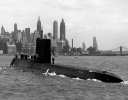 |
The photos below were taken by me on August 22, 2010, during a visit to the USS NAUTILUS museum at Groton, CT.
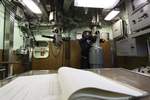 | 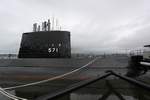 | 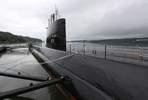 | Click here for more Photos. | |
 Back to Submarines list.
Back to Submarines list.  Back to ships list.
Back to ships list.  Back to selection page.
Back to selection page.  Back to 1st page.
Back to 1st page.